If economic resources were distributed based on principles of equity and human dignity, would those in the top one percent hold twenty-two percent of the world’s total income? Would the bottom fifty percent be left to share a mere nine percent? The obscenity of this disparity hides behind numbers: it means that millions of people are excluded from access to the most basic primary goods, while the most lavish luxuries are available in abundance to the privileged.
The too-familiar reality is that current resource distribution is not equal or equitable. In fact, economic inequality is on the rise. Recently constructed datasets show, for instance, that the top one percent of the distribution held “only” sixteen percent of the world’s income in 1980, while the share of income shared by the bottom fifty percent has remained stagnant. What gave rise to such an unexpected acceleration of inequality?
The capacity of wealthy families to transmit wealth on the sole basis of kinship has expanded.
A large body of evidence in economics shows that the increase in inequality is explained by several distinct phenomena occurring simultaneously. As one might expect, an expansion of the income of top managers and wealthy families explains the rise in the share of income held by those in the top one percent. Yet, inequality among those in the bottom ninety-nine percent is also rising, mainly between workers with a college degree and those without one. Both trends are equally alarming, especially in light of a third frightening development: a reduction of income mobility across generations within countries. These three phenomena are occurring in spite of outstanding episodes of economic growth in recent decades, which have so far failed to be sufficiently inclusive.
The top one percent
The rise of the income share at the very top of the world’s income distribution relates not necessarily to an increase in “earned incomes,” but to a rise in “capital income,” defined broadly as the sum of income derived from dividends, interest, and entrepreneurial rents. After the World Wars, capital income taxation prevented the income share of the top one percent from increasing, but globalization in more recent decades has rendered the existing taxation instruments ineffective. In particular, offshore tax evasion has been shown to be highly concentrated among the rich, with the richest .01 percent of households evading twenty-five percent of their taxes. With this recent rise in the ability to avoid taxation on capital income, the capacity of wealthy families to transmit—and enlarge—wealth on the sole basis of kinship has expanded, a fact that many find objectionable on moral grounds.
The increase in the income share at the very top is not fully explained by a rise in capital income, however. Executive compensation has also escalated wildly over the last forty years. For example, between 1980 and 2008, the US witnessed a six-fold increase in CEO pay. In accounting for this escalation, mainstream economic literature has pointed to the market capitalization of large companies, the high premium placed on executive talent and performance, and length of tenure as crucial drivers of such a trend; nonetheless, the salaries of top managers and executives continue to be a contentious issue in the public debate. A related but less examined phenomenon is the expansion of the owners of tech companies’ fortunes, in particular. While there is outrage aplenty at the Zuckerbergs and Cooks—not to mention the would-be “first trillionaire” Jeff Bezos—there is not as much light, yet, as there is heat.
The other ninety-nine percent
If society cared only about those lucky enough to belong to the elite, no further discussion would be necessary. Nevertheless, the other ninety-nine percent of the population, whose income is composed mostly of labor earnings, are also part of the obscene equation. Inequality between workers has most severely surged between those with a college degree and the rest of the workforce. One factor that explains some of this growing disparity is the increase in the returns on educational investment, also called the wage premium. Specifically, the ongoing growth in the college premium in the US is particularly salient: the income gap between households with a college-educated head and those with only a high school education went from $30,000 in 1979 to $58,000 in 2012.
The ‘birth lottery’ stakes are now higher than ever, with children born to poor parents becoming separated from their affluent peers.
As economics teaches us, supply and demand can help explain this phenomenon. Over the past three decades, the demand for high-skill jobs has been rising, at times even exceeding the supply of college graduates. On the other hand, the demand for low-skill jobs has diminished due, among other reasons, to automation, the globalization of manufacturing industries, and the progressive de-unionization of blue-collar workers.
This decline of living conditions among those without a college degree is not without social consequences. Evidence shows that the lack of a good job harms the marriage prospects of less-educated workers since earnings potential plays a vital role in a healthy marriage. Furthermore, advanced economies like the US have witnessed a rise in “deaths of despair” (see Deaton, 2020). In 2017 alone, the US lost more than 150,000 lives due to drug overdose, alcoholism, and suicides, ultimately resulting in a previously-unthinkable rise in midlife mortality. Not surprisingly, Americans without a bachelor’s degree run the highest risk of experiencing a death of despair.
Intergenerational mobility
As heartbreaking as it may be, the worsening of the living conditions of less-educated workers is not the most worrisome manifestation of the ongoing increase in inequality. Instead, a parallel stagnation of intergenerational mobility, defined as the ability of children to reach a higher income class than their parents, is the most preoccupying trend. In the US, children born today are no more likely to move up the income ladder than children born in the 1970s. Hence, the “birth lottery” stakes are now higher than ever, with children born to poor parents becoming separated from their affluent peers.
The origins of such nefarious disparity are no mystery. Many determinants of adult outcomes, including cognitive ability and “soft” skills, are formed during pregnancy and infancy. Research shows that many of these determinants are influenced early by parental disadvantage and that age only magnifies gaps between groups over time. Notably, inequality in early socio-emotional skills, shown by most of the existing academic literature to be a significant predictor of adult success, has increased between the children of more and less educated mothers over the past few decades.
Inequality and economic growth
While economies struggle to alleviate growing disparities, many also aspire to accomplish a better standard of living—an ambition of particular importance to low-income countries, where citizens often live in deplorable conditions. Although economic growth continues to be necessary, as it is strongly correlated with poverty reduction, an inclusive distribution of economic gains is equally essential. Old theories in economics asserted that the trickle-down effects of growth would automatically address income disparities, but newer evidence suggests otherwise. While there is a negative correlation between economic growth and poverty, the magnitude of this relationship is dependent on the level of inequality. For example, between 1980 and 2010, developing countries with decreasing inequality and high economic growth witnessed a decline in their poverty rate by 1.3 percentage points per year on average, compared to 0.42 percentage points on average for their counterparts with rising inequality.
The impact of COVID-19
The COVID-19 pandemic has highlighted the ethical challenge posed by the rising inequalities around the world. The virus has ravaged every segment of the population. However, it has hit the most vulnerable groups hardest, accentuating the fault lines in society and exacerbating long-standing divisions.
The lesson is clear: manifestations of inequality now include life and death. In the United States Native Americans, Blacks, and Hispanics have been disproportionately affected. These groups face increased risks, such as living in crowded homes and neighborhoods, using public transportation, and working in “essential” jobs under unsafe conditions. Additionally, they have less access to healthcare and share a more significant burden of chronic diseases like diabetes, which act as comorbidities for the coronavirus.
The economic turbulence of our time
The ride is becoming bumpier for families living in modern yet extremely unequal societies. More favorable winds may lie ahead, however. Carefully constructed labor policies, backed by an understanding of how to address the changes described above, can help mitigate the most unsettling trends. This possibility will be the subject of our next post—stay tuned.
Alejandro Estefan is assistant professor of development economics in the Keough School of Global Affairs at the University of Notre Dame. Belén Carriedo, Hugo Flores Navarro, Uriel Galace, Laura Guerra, Shadwa Ibrahim, and Eleanor Jones are second-year students in the Keough School’s master of global affairs program.
This article is part of a series of blog posts published by the Keough School of Global Affairs. Dignity and Development provides in-depth analysis of global challenges through the lens of integral human development.



